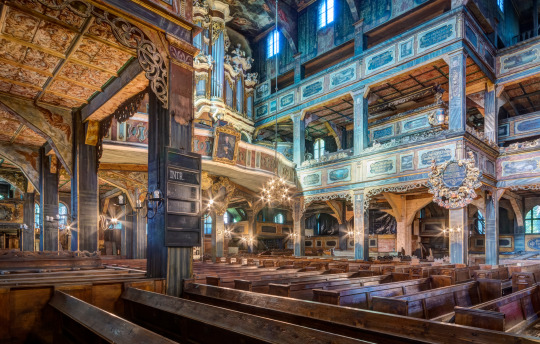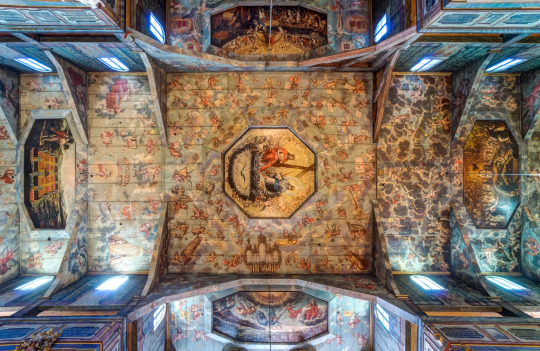#ratujmykosciolpokoju
Explore tagged Tumblr posts
Link
Can we agree that this pandemic has ruined enough things? Want to help with preventing it from ruining yet another one? The Evangelical Parish of the Augsburg Confession in Świdnica, Poland is currently trying to raise funds for the conservation and restoration of it’s church - one of the two remainig Churches of Peace, a UNESCO world heritage site. The matter is urgent: a local goverment subsidy has been withheld (the reasons are unclear, but I’ll take a gander that it’s due to huge loses of tax revenue that local goverments in Poland have seen as a result of fiscal reform and pandemic-related recession). Without raising the funds on it’s own, the Parish will lose access to EU funding. Since during the pandemic the tourist traffic is much smaller than usual, crowdfunding is pretty much the only option.
Why is this important?
The Church is a memento of the Thirty Years War (1618-1648) - the total war before total wars, a conflict that has shaped much of Europe’s modern culture and history. During and after the war the Habsburg emperors tried to forcefully re-catholicize the Protestant territories under their rule. The Churches of Peace were the last foothold of religious freedom in the Habsburg-ruled 17th Century Silesia. As former Protesnant churches in the region were being seized by the Habsburg army and handed over to Catholics, the king of Sweden pushed for the Lutherans to be allowed to build new churches in which they could practice their religion freely. It was one of the conditions of the Peace of Westphalia.
There were, however, many restrictions on what they could actually build. For staters: no masonry. The builders could only use timber, clay, sand and straw - which makes the conservation of such a structure incredibly demanding. The churches could not resamble a traditional Christian temple and they couldn’t have spires or belfries. They had to located outside of the city walls, but within the reach of a cannon shot. Plus, they had to be started and finished within one year.

Photo by Sławomir Milejski at Wikimedia Commons, CC BY-SA 3.0 pl (x)
The architect Albrecht von Säbisch went above and beyond the technical possibilities of his era and created Europe’s largest timber-framed religious buildings whilst keeping the strict deadlines. If innovative carpentry is not your thing, the Churches of Peace are also notable for their unique sulptural and pictorial deocration. While Protestant churches tended to be rather austere, especially when it came to religious imagery, wooden and timber-framed structures flipped this tendency on its head. As if to compensate for the inferiority of materials, the walls of the Churches of Peace (and other similar structures, such as the wooden Articular Churches of Slovakia) are covered floor to ceiling with paintings, sculptures and ornaments so rich and detailed as if they were meant to rival the splendors of Papal Rome during the Counter-Reformation. This gives us a rare glimpse at how the Baroque artistic conventions, many of which were invented in order to glorify the Catholic Church, could be modified to represent a different religious dogma.

Photo by Jar.ciurus at Wikimedia Commons, CC BY-SA 3.0 pl (x)
These days the Church in Świdnica is a symbol for international and interreligious reconciliation efforts. The chancelors of Gemany and the prime ministers of Poland prayed for peace together here in 1989 and in 2014. In 2016 Dalai Lama visited the Church to sign the Appeal for Peace, alongside with Poland’s spritual leaders of Christianity, Judaism, Islam, and Buddhism.
To support the conservation efforts you can donate to the Parish’s fundriser at the link above. Please spread the news using the hashtag #ratujmykosciolpokoju (save the Church of Peace). I’ll be posting about the Churches of Peace until the end of the month in order to bring attention to the fundraiser.
#ratujmykosciolpokoju#baroque#Architecture#baroque architecture#poland#silesia#śląsk#schlesien#świdnica#schweidnitz#church of peace#timber-framed building#german art#polish art#thirty years war
4 notes
·
View notes
Photo



Interior of the Church of Peace in Świdnica (Schweidnitz). Upon it’s completion in 1657 (after just 10 months of construction!) this church was amongst the largest timber-framed structures in Europe and was ready to house a congreagation of 7500. While the exterior of the building was rather modest due to limitations put on Protestant churches in Silesia by the Habsburgs after the Thirty Years War. The lavish decorations of the exterior were meant to compensate for that. As you can imagine, a lot of money and effort went into them with some wealthy parishioners decorating their family “boxes” - like the Lodge of the Hochberg Family you can see in the photo in the middle.
There are only 4 days left to support the conservation of this building!
More info about the fundraiser here.
Photo credits:
Andrzej Ostębski at Wikimedia Commons, CC BY-SA 3.0 (x)
Jar.ciurus on Wikimedia Commons, CC BY-SA 3.0 pl (x) (x)
#ratujmykosciolpokoju#church of peace#baroque#baroque architecture#art history#history#architecture#poland#polska#silesia#śląsk#schlesien#dolny śląsk#świdnica#schweidnitz#17th century
2 notes
·
View notes
Photo


The Church of Peace in Głogów (Glogau) was the first of the three timber-framed churches catering to the religious need of Silesian Protestants in the 17th Century in accordance to the stipulations of the Peace of Westphalia. It is also the only of the three Churches of Peace that was ever destroyed. First built 300 paces outside the town walls in 1651-1652, it famously fell on its side during a hurricane in 1654. After it was rebuilt in 1655 and eventually fell victim to the great fire of Głogów in 1758. By then - as a result of the Silesian Wars - Głogów became part of the mostly Protestant Kingdom of Prussia, so the Lutherans were granted the right to build their new church in the centre of the town, instead of rebuilding the old one on the outskirts.
The images above are by Friedriech Bernhard Werner, whocreated a series of panoramas depicting the cities and towns of Silesia, and then set out to document the Protestant Churches of the region (despite being a Catholic). The illustrations were created in the 1730s and 1740s, about twenty years before the eventual destruction of the Church of Peace. In the panorama, you can spot the Church near the right margin.
Want to support the conservation of the preserved Church of Peace in Świdnica? Click here for more information!
#ratujmykosciolpokoju#art history#history#baroque#architecture#17th century#18th century#silesia#śląsk#schlesien#dolny śląsk#głogów#glogau#poland#german art#german architecture#church of peace#timber frame#catastrophes
1 note
·
View note
Photo




Then and now: Churches of Peace in Świdnica (top row) and Jawor (bottom row)
The Church of Peace in Jawor (Jauer) was built was built in within 12 months in 1654-1655. The church in Świdnica (Schweidnitz) soon followed after: it was completed in just ten months in 1656-1657. Why the rush? You could say it was the law. The construction of the churches was regulated by the Peace of Westphalia which concluded the Thirty Years War. The peace settlement granted the Protestants in the Habsburg dominions in Silesia the right to build three churches, thus preserving a modicum of religious freedom in the region. However, it place a number of limitations on what and how they could build, making sure that all the buildings had to be constructed within a year and using “impermanent” materials only: timber, straw, clay and sand. Thanks to the ingenuity of the architect Albrecht von Säbisch, the churches were not only completed within the deadline, but also proved surprisingly durable.
The illustrations above were created by Friedrich Bernhard Werner between 1748 and 1752 as part of his series documenting the Protestant churches of Silesia (all the more interesting because Werner himself was Catholic). At that time, the protestant communities in Silesia were no longer bound by all the stipulations of the Peace of Westphalia: you can see that belfries and other towers were added to the church complexes, while the peace treaty originally forbade both.
The Parish in Świdnica is urgently collecting funds for the conservation of the Church of Peace, a UNESCO World Heritage Site. You can donate here. More info (in English) about the fundraiser in my previous post here.
Photo credits:
Renardo la vulpo at Wikimedia Commons, CC BY-SA 4.0 (x)
Sławomir Milejski at Wikimedia Commons, CC BY-SA 3.0 pl (x)
#ratujmykosciolpokoju#art history#history#Architecture#baroque#baroque architecture#silesia#ślask#schlesien#dolny śląsk#świdnica#schweidnitz#jawor#jauer#poland#german art#german architecture#thirty years war#reformation#unesco#17th century#18th Century
1 note
·
View note
Photo


The main altarpiece of the Church of Peace in Świdnica (Schweidnitz) was comissioned in 1752 to celebrate the centennial of the building and, quite like the church itself, was finished within a year.
The relief of the predella - the lowermost part of the altarpiece, just above the altar table, shows the Last Supper. It was a popular choice for Lutheran altarpieces since the beginning of Reformation. Martin Luther himself recommended the scene as a subject of altarpiece paintings, believing it’d direct the attention of the faithful to the meaning of the Eucharist.
The main sculpture shows the Baptism of Christ, referencing the other of the two sacraments of the Augsburg Confession.
It might seem surprising how much in line this altarpiece is with the triumphant conventions of the Catholic altarpieces of the era, such as the works of the Austrians Fischer von Erlahs. Perhaps it’s the question of proximity. Or perhaps it’s the fact that Silesian Protestanst had some reasons to feel triumphant in 1752. As a result of the first and second Silesian War huge part of the region was seized by Prussia. And while Frederick the Great was far from the Protestant fanatism of some of his successors on the Prussian throne, the Lutherans of Silesia had much better conditions under his rule, than they exprienced under the reign of militantly Catholic Habsburgs. In fact, the first people to great Frederick after he crossed the boarder of Silesia in 1740 were the pastors from another Church of Peace, the one in Głogów (then Glogau). As they pleaded for him to save the few protestant churches from bombardment, he assured them of their safety and accepted them as his first Silesian subjects.
The Parish in Świdnica is urgently collecting funds for the conservation of the Church of Peace, a UNESCO World Heritage Site. You can donate here. More info (in English) about the fundraiser in my previous post here.
Photo credits:
Barbara Maliszewska at Wikimedia Commons, CC BY-SA 3.0 pl
bnorbert3 at Wikimedia Commons, CC BY-SA 3.0 pl
#ratujmykosciolpokoju#church of peace#art history#history#Architecture#sculpture#baroque art#18th Century#german art#poland#silesia#śląsk#schlesien#dolny śląsk#silesian wars#frederick the great#świdnica#schweidnitz
1 note
·
View note